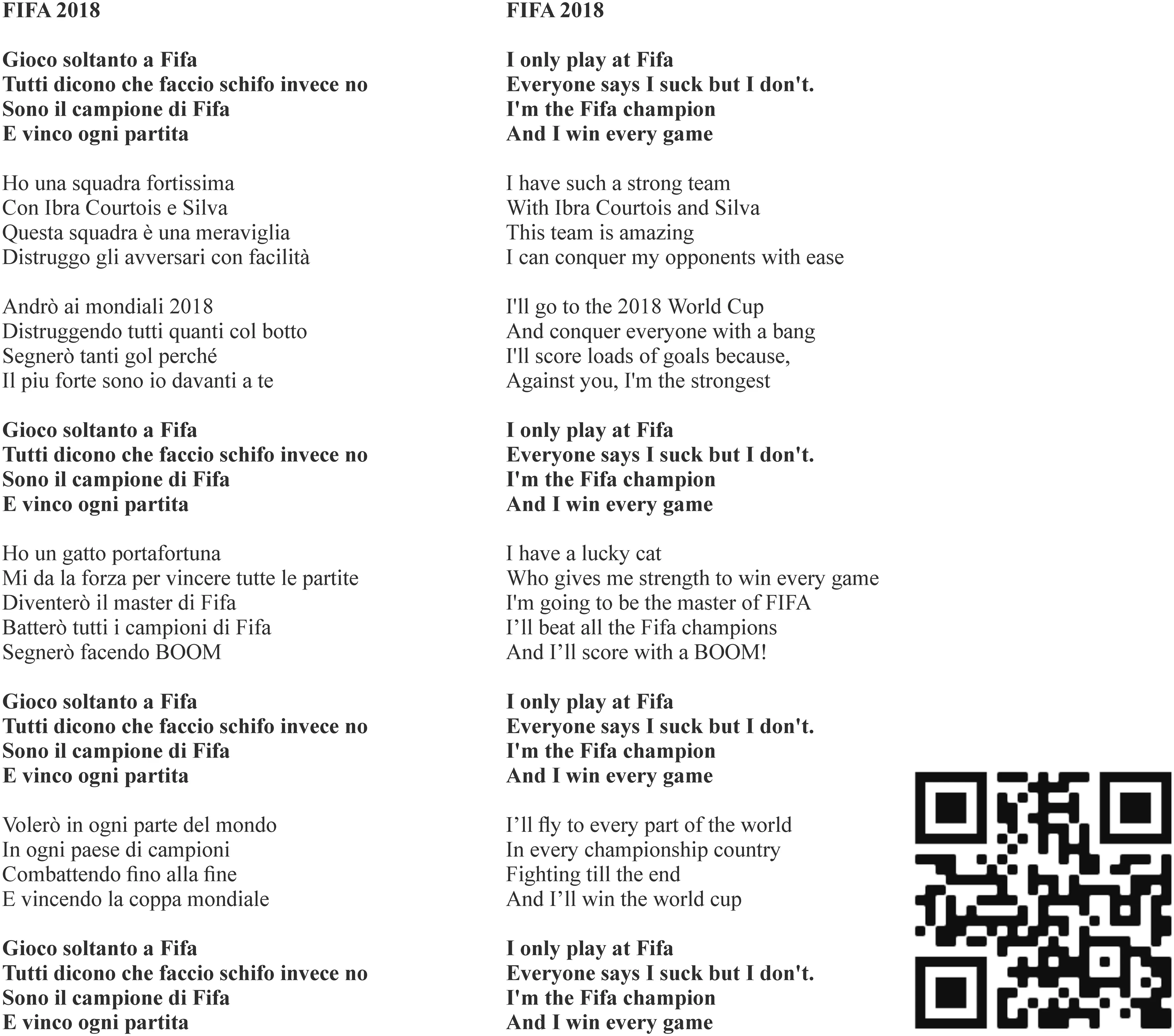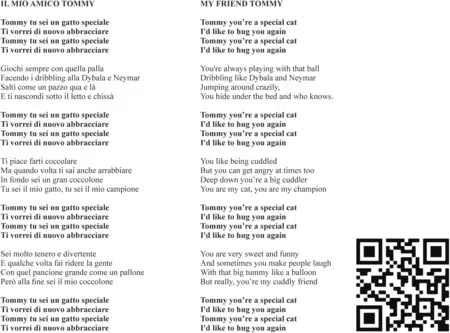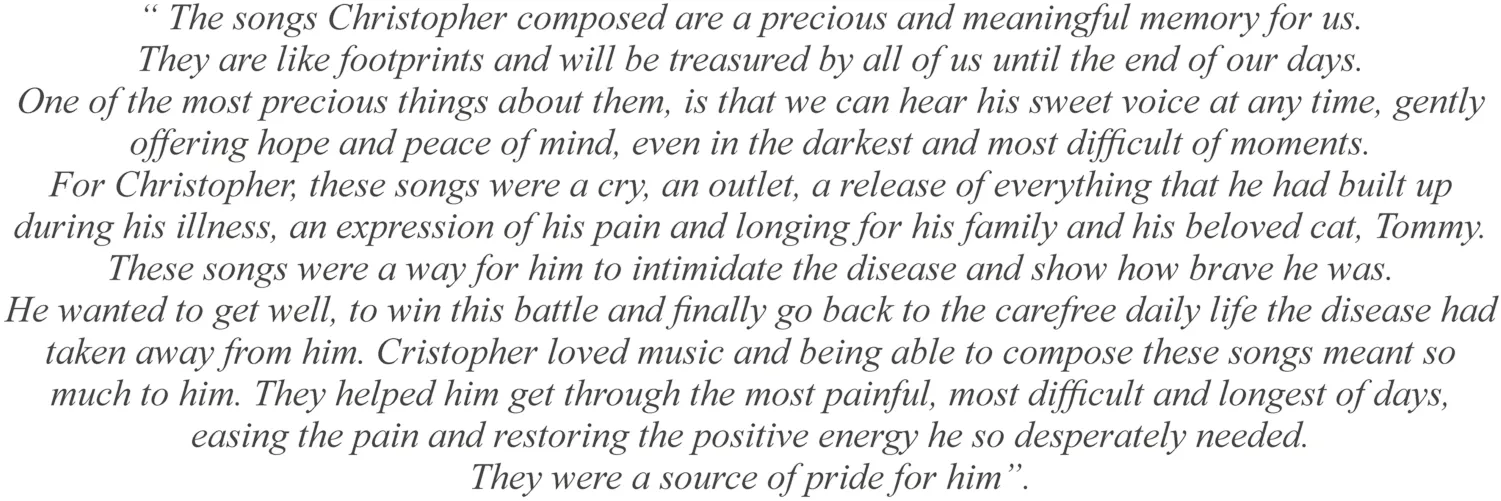Music therapy and pediatric palliative care: songwriting with children in the end-of-life
2022-11-08ilippoGiordanoChiarFaRutiglianoMariagraziaBaroniMassimoGrassiPaolaMuggeoNicolaSantoro
ilippo Giordano · ChiarFa Rutigliano · Mariagrazia Baroni · Massimo Grassi · Paola Muggeo · Nicola Santoro
Children’s needs in pediatric palliative care (PPC) are complex and are determined by age, the course of the disease,family structure, and cultural background [ 1]. The child’s family system also has multiple needs which must be properly assessed and managed [ 2].
Children and their families need medical, social, and emotional support, attention to spiritual well-being, and accurate assessment and management of physical and psychological symptoms. The encompassing framework of care must be a dynamic model that can shift focus according to the needs of the patient at any given time [ 3] and that can off er high-quality communication and advanced-care planning. In end-of-life accompany, even greater care is required for the patient and their family by the highly specialized multi-disciplinary team [ 4] using a clear and well-organized interdisciplinary and interprofessional holistic approach [ 5,6] and a biopsychosocial model of health [ 7].
Music therapy is def ined as clinical and evidence-based use of music interventions by a trained professional for the purpose of achieving individualized goals within a therapeutic relationship between patient, music, and music therapist[ 8]. This therapy is increasingly used as a complementary approach in palliative care.
In music therapy, songwriting (SW) is one of the most explored and applied techniques in palliative care [ 9— 11],because SW can (unconsciously or voluntarily) give voice to what cannot be expressed directly through words alone.SW can leave tangible memories for loved ones and can help patients to regain a sense of control over their lives and to express feelings and experiences valuable for children and their families [ 12]. The eff ectiveness of SW in oncological contexts has been documented [ 13— 15]; however, case report or individual experiences in the setting of children in the end-of-life are lacking in the literature. The focus of SW is not on the f inal result but is more on the process that f irst allows emotional and then musical elaboration to take place.As a therapeutic intervention, SW has cognitive, as well as emotional, physical, and spiritual dimensions. This contribution contains the story of Christopher, an 11-year-old child aff ected by leukemia, and his latest songs.
The theoretical basis of this work is rooted in experienceoriented music therapy and, its approach is family centered[ 11, 16— 18].
Christopher
Christopher, a 11-year-old patient and the second child in a family with three children, was hospitalized for acute undifferentiated myeloid leukemia (AUML). He began treatment according to protocol AIEOP LAM 2013, which was based on three cycles of intravenous and intrathecal chemotherapy(induction 1 and 2, consolidation) and supportive therapy(anti-infective prophylaxis, nutritional support, pain therapy and antiemetic therapy). He achieved complete remission.After resolution of prolonged bone marrow aplasia complicated by mycotic sepsis, Christopher received hematopoietic stem cell transplantation in April 2017.
Christopher, a mature, sensitive, polite and discreet child,was able to adapt positively to the hospital context, showing trust and compliance towards all the medical staff . He loved football, cats and playing Fifa18®on Playstation®. His mother was a very positive presence, who stimulated, supported, contained, and reassured him. During hospitalization, Christopher participated in several individual bed-side music therapy sessions. Music therapy was off ered as a continuous and constant service of Dominga project (APLETI)in the Pediatric Oncological Hematology Department of the AUOC Policlinico Bari, Italy since 2013 [ 19].
In January 2018, Christopher was diagnosed with a bone marrow recurrence of AUML that could not be treated, and the child would inevitably deteriorate acutely. In March 2018, he was again hospitalized in the Pediatric Oncological Hematology Department of the Bari hospital. Christopher had persistent bone marrow aplasia, moderately reduced respiratory function (requiring minimal oxygen therapy),arterial hypertension (despite antihypertensive therapy and extensive oral diuretic) and moderate increase in bilirubin.He was treated with parenteral steroid therapy, broad spectrum antibiotic, and antifungal therapy on a daily basis.
Christopher was very fatigued, but he had his usual smile.He was warm and kind to everyone, and he did not give up on any activity that was proposed to him. Music therapy was recommended by a psychologist to Christopher, and he agreed to work with songwriting for the second time during his treatment. The aims were to support, contain and accompany him through his illness, to help give meaning to each day, and to stimulate and reinforce the relationship with his mother and family.
Christophe’rs songs
Christopher was very determined when the music therapist proposed writing a new song. He said he wanted to open a YouTube channel with his original songs and to compose a new one in rap style telling how “I'm good at Fifa, I don’t suck”. The process of SW took four sessions, each lasting from 10 to 40 minutes. The music therapist actively involved him both in the writing of the text and in the arrangement of the music.

Fig. 1 Lyrics (Italian and English) and QR code for listening
Christopher, thanks to the intuitive screen of the GarageBand®application, was able to choose how many and which instruments and/or sounds to use. His mother was in the room and actively participated in drafting the text. In the f irst session, he was able to compose two verses and the chorus of his new song. In the following sessions,Christopher worked a lot on the details together with the music therapist and searched for the most suitable sounds and musical arrangement. The whole process was shared on a daily basis with the psychologist at the pediatric cancer clinic. As the psychologist explained, the words of the song seemed to show how he fought current situations and to tell of his desire to win over everything and everyone.
The music was repetitive, like a mantra, suspended,almost timeless, and quite hypnotic. The melody was simple,with close intervals, like spoken narrative more than a real melody. When everything was set up, Christopher decided to record the song with his own voice (Fig. 1). This was done in his hospital room with adequate equipment. Christopher chose the title “FIFA 18” and immediately wanted to compose another one.
Christopher’s clinical conditions worsened very quickly,but he had a clear idea of the new song and was very determined to compose it. “I would like to write a love song for my cat, but I’m not very good at writing this kind of song”.The music therapist asked what his cat was called and to tell him something about the cat. Christopher replied that his name was Tommy and that he missed him very much.
With the music therapist accompanying this moment with a guitar, Christopher began to tell stories about his cat by singing a tune. The whole song was ready in 25 min. The lyrics were heartbreaking with a delicate and essential musical accompaniment. In this song it was possible to perceive and listen to his desire to meet his loved ones, to rediscover his bonds, to go back home to his family and hug them again.This was evident in the musicality of his voice and in the sound of his breath. These two elements were able to represent his physical and psychological state in a more authentic and truthful way than the words themselves. It was a chance to express his state of melancholy and nostalgia (Fig. 2).
Christopher was very fatigued and sleepy. Two more sessions were used to record the song, as Christopher requested.Due to labored breathing, it was necessary to record the f irst chorus and then the verses individually several times. The mixing was done almost simultaneously with the recording.All the pathos was in the slow and fatigued breath, between one musical phrase and the next, and in the silences that anticipated his thin, weak, whispering voice full of sweetness and tenderness. Listening carefully to him, one can get the impression of being in front of the light of a candle which, slowly, is running out. Christopher chose the title “My Friend Tommy”.This would be the last session of music therapy for him.

Fig. 2 Lyrics (Italian and English) and QR code for listening

Fig. 3 Letter from Christopher’s mother, a few months after his death
SW in music therapy can be a very powerful tool, to support and accompany both a child and their family in the most diffi cult and painful moment of death. SW helped Christopher to overcome the fear of abandonment that terminal patients may experience, off ering some perspective to his f inal days that may otherwise have been lacking [ 20]. Through songwriting, Christopher was able to make choices and act on his own will. This represents a key element in the accompaniment to the end of life[ 21]. The songs became something tangible, a product with their own consistency, and created a further bond that unites Christopher to his family to this day (Fig. 3). In SW, the songs composed can create bonds beyond all limits, challenging the possibility that time has to steal loved ones away. Songs possess the art of memory, in which the essence of that person, their voice, their breath, the thought of them in the minds of their loved ones, can be expressed and held [ 22].
Working alongside a child near death means choosing to enter, with great delicacy and humility, into a crystal room.The music, the melody, the chords, and words can f ind inspiration from silence, but only if necessary. Much of the time the room is cloaked in darkness; sometimes there is a thread of light; still others sunlight shines through. But the sense of gratitude and absolute privilege is always overwhelming.
AcknowledgementsThe authors wish to thank APLETI ODV for their passion, love and care in supporting for 41 years, the children with cancer and their family hospitalized at Unit of Pediatric Hematology-Oncology in AUOC Policlinico of Bari (Italy). Being together with Cristopher and his family, for us, has been a privilege and a great honor.Our greatest thanks to them.
Author contributionsFG: conceptualization, investigation, methodology, writing—original draft; CR: conceptualization, supervision;MB: methodology and supervision; MG: writing—original draft; PM:writing-review and editing; NS: writing-review and editing. All authors approved the f inal version of the manuscript to be published.
FundingNone.
Data availabilityIt was not applicable to deposit data in a public repository.
Declarations
Conflict of interestNo f inancial or non-f inancial benef its have been received or will be received from any party related directly or indirectly to the subject of this article.
Ethical approvalThe study was approved by Ethics Commitee of University Hospital of Bari (No. 5340).
Consent for publication Written consent for publication of the case and details has been obtained from the patient's parents.
杂志排行
World Journal of Pediatrics的其它文章
- Single ventricle: amphibians and human beings
- Clinical diff erences among racially diverse children with celiac disease
- Effi cacy of live attenuated vaccines after two doses of intravenous immunoglobulin for Kawasaki disease
- Associations between body mass index in diff erent childhood age periods and hyperuricemia in young adulthood: the China Health and Nutrition Survey cohort study
- Frequency and safety of COVID-19 vaccination in children with multisystem inf lammatory syndrome: a telephonic interview-based analysis
- Secondary genomic f indings in the 2020 China Neonatal Genomes Project participants
